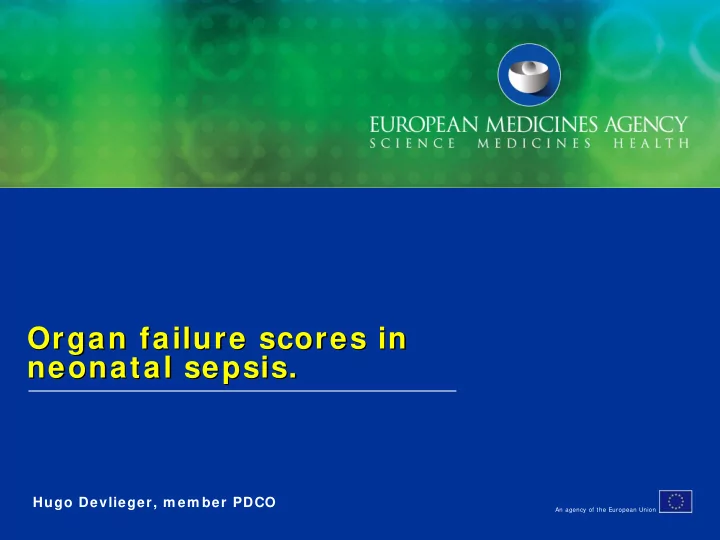

Organ failure scores in Organ failure scores in neonatal sepsis. neonatal sepsis. Hugo Devlieger, m em ber PDCO An agency of the European Union
Classical end-point: all-cause short term (28d. ) mortality Neonatal sepsis has low mortality: large study population needed: Cohen-Wolkewiez et al. 2009: near term EOS: total 1,3% mortality but 19,1% in Gram neg. Sepsis. LOS: 0,4% mortality but 24% in Gram neg. Choice of 28 days is arbitrary and may be too short Attributing death to sepsis as opposed to the underlying disease is difficult Withdrawal of intensive care clouds mortality as an end-point End-of-life decision preceded death in 95% in Dutch NICU (Verhagen et al. 2009) Mortality is insensitive to other important clinical outcomes as neurologic morbidity → Disability-free survival
Organ dysfunction scores ? As the magnitude of organ dysfunction is a key element in defining the severity of sepsis, this should be reflected in the endpoints ↕ The interaction between sepsis and multiple organ failure is only poorly defined in children (Leclerc et al. 2005) Degree of organ dysfunction and the number of failing organs differ in the individual patient over time often independently of the course of the infection No distinction is possible between the course of the disease and the impact of treatment. 3
Organ dysfunction scores ? In the newborn infant patterns of organ dysfunction can be identified which correspond to the severity of the sepsis. Hence “time to organ dysfunction resolution” can be derived as a single alternative end point to mortality 4
All organ dysfunction scores are not equal Prognostic scores aim to describe the severity of illness based on co-morbidities, and/ or some physiological disturbance at baseline of groups of critically ill patients and to derive the mortality or morbidity risk of the newborn: (SNAP, SNAPPE, SNAPII, SNAPPEII, CRIB II, NTISS etc.) single shot scores are not intended to assess day-by-day evolution of morbidity as a result of therapy do not provide detail on disease progression or response to treatment Do not include perinatal items as PPROM, APGAR, etc Partial risk adjustment in observational studies Validation of the randomization Stratification of patients at entry in a RC trial Selection by means of severity index the group of patient for which 5 there is the greatest chance to demonstrate a treatment effect
Outcome score in neonatal care Describes the severity of illness based on specific organ dysfunction and failure due to sepsis on a day-by-day base Requirements of reliable score in sepsis to be used as a surrogate for disability-free survival and basis for validation as defined by Tarnow- Modi (2005): 1) a causal connection should exist between change in the score and change in disability-free survival 2) the score fully captures all the effects of treatment on “disability-free survival”. 6
Neonatal Multiple Organ Dysfunction Score (Janota J et al. 2001) Developed in 142 VLBW infants (< 31w GA and< 1500g BW) Daily scoring of seven organ systems (CNS, cardiovascular, renal, respiratory gastrointestinal, haemocoagulation and acid- base status. Scoring up to 28 days after birth 7
8
NEOMOD score 9
Neomod score <28w ≥ 28w <1000g ≥ 1000g 10
Comment on the NEOMOD score Designed as a predictive score but can be used as a one-off score as a daily or as a Delta score Can not be applied for term and preterm infants ≥ 1500g The CNS criteria are specific for the VLBW infant Liver dysfunction is not included in the score while it is an important target in neonatal sepsis 11
Adaptations to the NEOMOD score Adapted CNS score: ex. Sarnat score or other Liver dysfunction: cholestatic icterus should be included Other organ dysfunction? 12
Alternatives: Sequential Organ Failure Score Time to recovery of organ failure New organ failure Organ failure–free days (from enrolment to 28 days) e.g Activated Prot C trial “free days” Ventilator free days, vaso-active drugs free days Adaptation of the paediatric scores MODS score PELOD score P-MODS score 13
PELOD score
Cardiovascular dysfunction
Respiratory failure
Other organ dysfunction
P-MODS 18
Alternatives: Severity of illness score originally designed as predictive scores can be sequentially assessed as for example the NTISS. This reflects, however mainly the treatment received by the infant and is not accurate as a surrogate end- point as it is based on the assumption that therapeutic intensity is a direct correlate of illness severity. 19
Conclusions The only published outcome score in neonatal care is too limited to apply to all newborn infants The score has never been applied in a RT Adapted paediatric scores may be useful in neonatal trials Scores are not addressing organ dysfunction in the specific condition of sepsis although sepsis is the major cause of organ dysfunction in the NICU as well as in the PICU 20
CRIB 21
CRIB II 22
CRIB II 23
NTISS 24
SNAP 25
SNAPP II 26
SNAP II 27
Recommend
More recommend